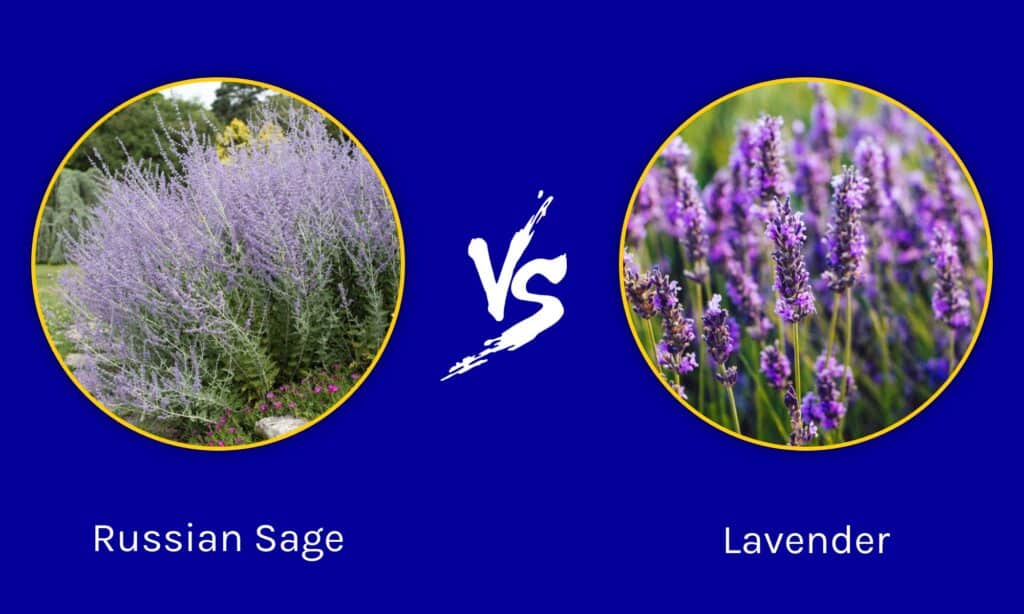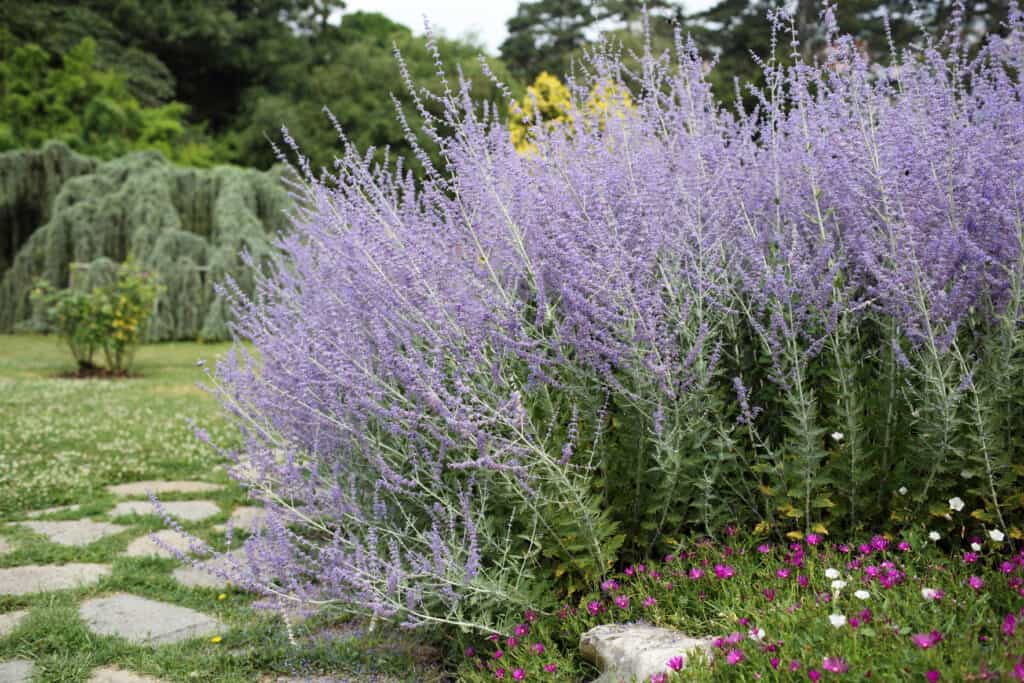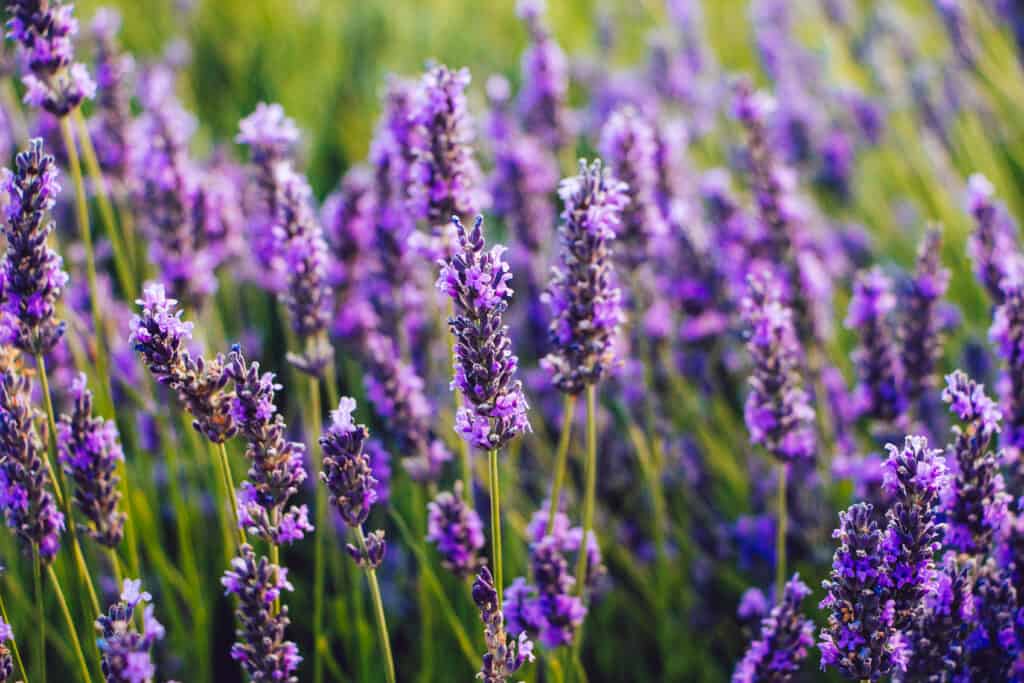Russian sage and lavender are beautiful, herbaceous flowers that look great in a wild garden and have both culinary and medicinal purposes. Both are easy to care for with lovely violet blooms. So, Russian aage vs. lavender: while these two plants are similar in appearance and maintenance needs, there are a few notable differences. This article will discuss the differences between Russian sage and lavender so you can determine which is right for your garden.

Russian Sage vs. Lavender: A Comparison
| Russian Sage | Lavender | |
|---|---|---|
| Classification | Salvia yangii | Lavandula spica |
| Alternative Names | Perovskia atriplicifolia | N/A |
| Origin | Central Asia | Africa, Asia, Europe |
| Description | A wild subshrub that grows in vertical clumps with small blue-violet flowers. Most Russian sage varieties grow up to five feet tall and four feet wide. Some hybrid varieties grow smaller, up to two feet, and more upright than traditional species’ “weeping” appearance. Stems are delicate and soft gray-green with soft, silver hairs. Emits a minty, floral, earthy aroma. | A wild semi-shrub grows in vertical stalks. Named for the color of its blooms, lavender can also have white, pink, yellow, or dark purple flowers. Plants can grow two to three feet tall, with stalks measuring 12-16 inches long. Emits a delicate, sweet, floral aroma. |
| Uses | Traditionally used in herbal medicine and tea for indigestion. Also used in cooking and mixology. Essential oil derivatives are used in pest control. | Commonly used in aromatherapy for treating anxiety and stress. Also used in baking and mixology. |
| Growth Tips | Germinate seeds in a moist, warm environment for up to four months. This drought-tolerant plant grows in USDA zones 4-9. Plant outside in full sun with dry, well-draining soil. Keep roots moist until established, then water infrequently. Deadhead blooms in the fall and trim back in the spring to promote new growth. | Germinate seeds in a moist, warm environment for up to one month. Alternatively, plant cuttings for a higher success rate. This drought-tolerant plant grows in zones 5-9. Plant outside in full sun with dry, well-draining soil after the danger of frost has passed. |
Key Differences Between Russian Sage and Lavender
Russian sage and lavender are easily confused with one another. It tends to be taller and narrower, whereas lavender is shorter and wider. Russian sage blooms are more muted and grow along the stalks, while lavender blooms are more vibrant and bunched at the top.
Let’s explore some of the differences between Russian sage and lavender in detail.
Russian Sage vs. Lavender: Classification
Russian sage and lavender are members of the family Lamiaceae, which they share with many aromatic herbs, such as mint, basil, and rosemary. While lavender is often portrayed as a flower, it is, in fact, a herb.
Russian sage is in the genus Salvia with rosemary. It was previously classified as Perovskia atriplicifolia during the 1830s. Both Russian sage and rosemary were reclassified as Salvia in 2019 by the RHS Nomenclature and Taxonomy Advisory Group.
Lavender is in the genus Lavandula with mint with 46 other flowering plants. English and French lavender variants are the most common for gardening.
Russian Sage vs. Lavender: Origin
Despite its name, Russian sage isn’t native to Russia. It was discovered by a Russian botanist named Karelin in 1840 and was named after Turkestani ruler B. A. Perovski. This plant is native to Central Asia and is typically found at high altitudes in Afghanistan, Pakistan, and Tibet.
Lavender variations originate from Europe, Asia, and Africa but can now grow in almost every part of the world.

Despite its name, Russian sage comes from the steppes and hills of Asia.
©iStock.com/loflo69
Russian Sage vs. Lavender: Description
Russian sage grows up to five feet tall and four feet wide. Flowers on this fast-growing plant have conical stalks with blooms evenly distributed along the stem. Blooms grow up to one inch across and have a muted blue-violet color framed by silvery green stems and leaves.
Russian sage has an earthy aroma with notes of mint and sometimes lavender. The blooms are edible with a mild, peppery flavor, while the leaves and stalks are toxic.
Lavender grows up to three feet tall and four feet wide. Blooms are typically a vibrant lavender color but can also range from dark purple to white. The blooms grow to half an inch at most and are closely bunched near the top of the stalk.
Lavender has a strong, sweet, floral aroma and flavor profile. It often has undertones of mint and earthiness. The blooms, stems, and leaves are all edible.
Russian Sage vs. Lavender: Uses
Both Russian sage and lavender are used in herbal medicine and for culinary and mixology purposes. Russian sage is traditionally used in tea to settle gastrointestinal distress. It’s also featured as a garnish in some Middle Eastern salads.
Lavender is featured heavily in aromatherapy for its calming, anti-anxiety effects. It’s often included in baked goods and desserts, paired with berries and citrus. In mixology, lavender simple syrup adds a nice pop of color and floral undertone.

Lavender is known for its calming effects.
©iStock.com/ASIFE
Russian Sage vs. Lavender: Growth Tips
Both Russian sage and lavender are challenging to grow from seed. It’s easier to grow both of these plants from cuttings.
To grow Russian sage from seed, germination must occur in a warm, moist environment. This process can take up to four months. Transplant sprouts to well-draining soil after the risk of frost has passed.
Keep roots moist until the transplant is well-established, then water this drought-resistant plant every two weeks during dry periods. While Russian sage can grow in USDA zones 4-9, mulch or additional root protection should be added during the winter in colder zones. Cut Russian sage back every couple of years to reduce runaways.
Growing lavender from seed also requires a warm, moist environment. Seeds typically germinate in approximately a month. Transplant sprouts to well-draining soil after the risk of frost has passed.
Lavender is an ideal companion for vegetable gardens as it attracts pollinators and deters pests. Keep roots moist until the transplant is well-established. After the first year, avoid watering as lavender is more drought-resistant and prone to root rot than Russian sage.
The photo featured at the top of this post is © iStock.com/ASIFE
Thank you for reading! Have some feedback for us? Contact the AZ Animals editorial team.






